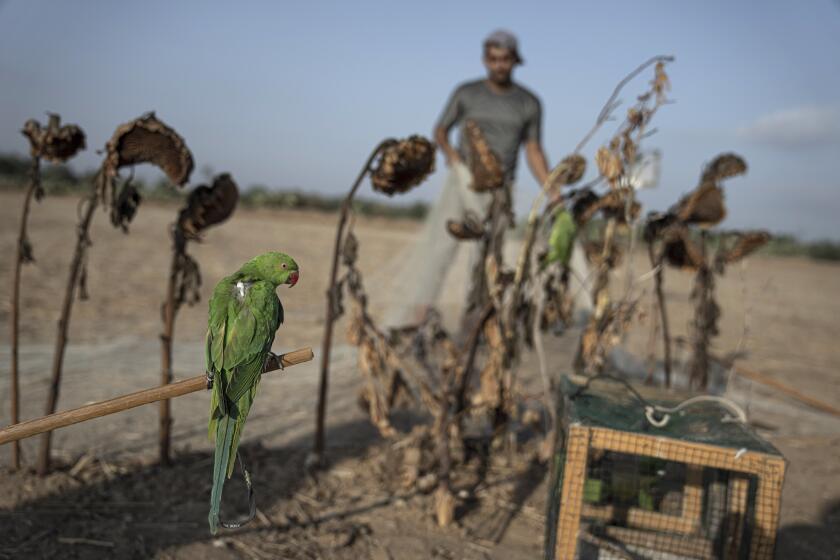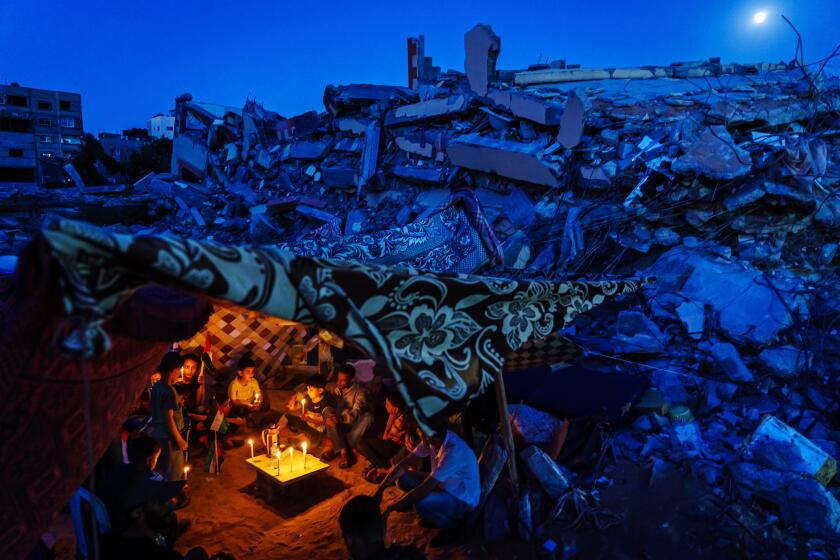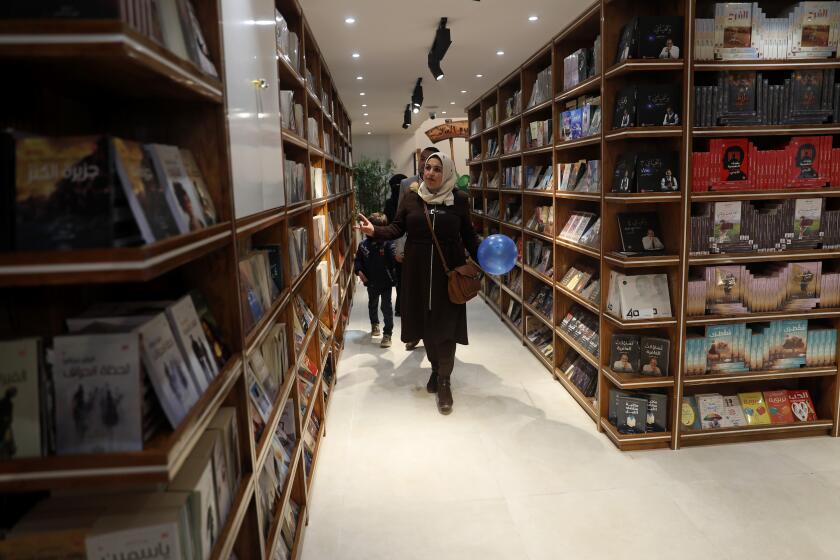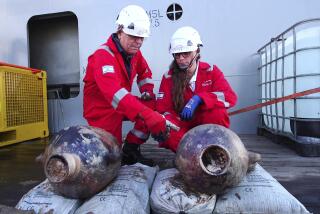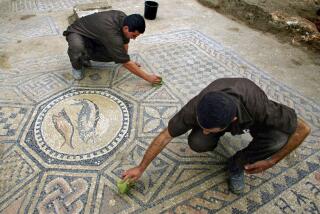Palestinian farmer discovers rare ancient treasure in Gaza
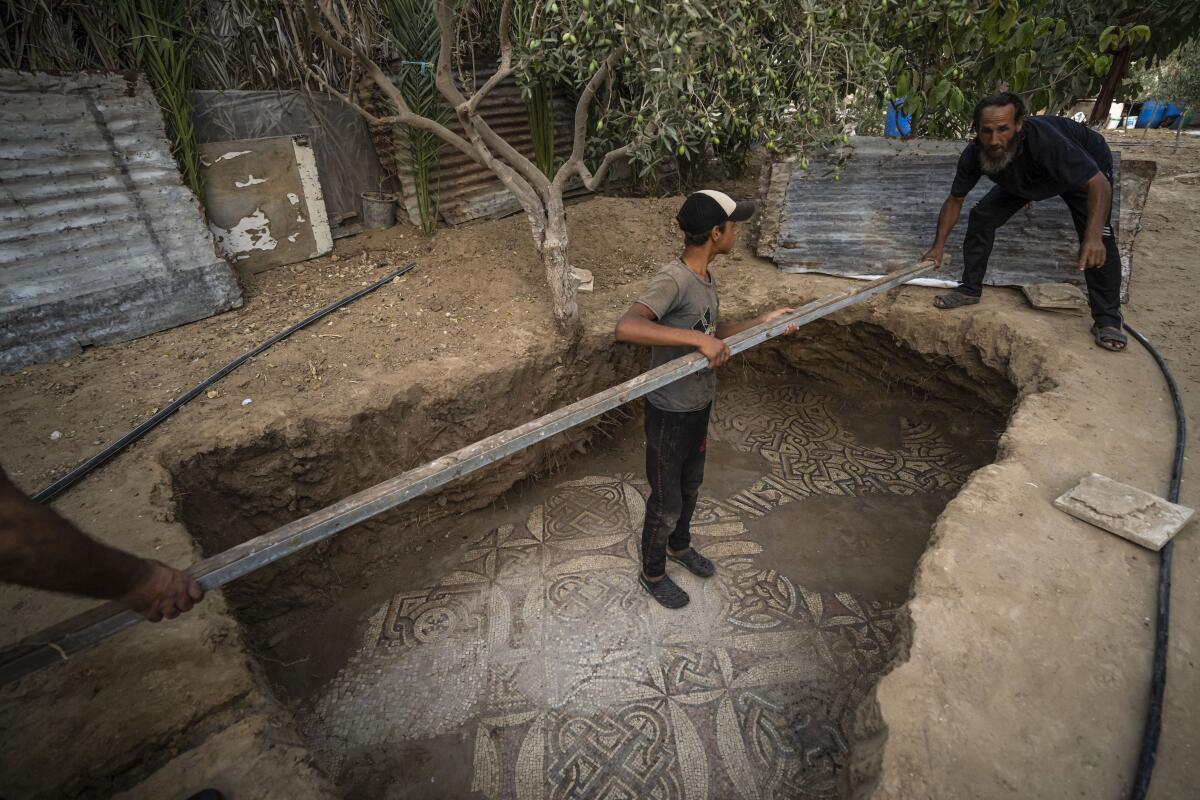
- Share via
BUREIJ, Gaza Strip — Last spring, a Palestinian farmer was planting a new olive tree when his shovel hit a hard object. He called his son, and for three months, the pair slowly excavated an ornate Byzantine-era mosaic that experts say is one of the greatest archaeological treasures ever found in Gaza.
The discovery has set off excitement among archaeologists, and the territory’s Hamas rulers are planning a major announcement in the coming days.
But it is also drawing calls for better protection of Gaza’s antiquities, a fragile collection of sites threatened by a lack of awareness and resources as well as the constant risk of conflict between Israel and local Palestinian militants.
The mosaic was uncovered just half a mile from the Israeli border. The floor, boasting iconography of 17 beasts and birds, is well-preserved, and its colors are bright.
“These are the most beautiful mosaic floors discovered in Gaza, both in terms of the quality of the graphic representation and the complexity of the geometry,” said René Elter, an archaeologist from the French Biblical and Archaeological School of Jerusalem.
“Never have mosaic floors of this finesse, this precision in the graphics and richness of the colors been discovered in the Gaza Strip,” he said.
Dozens of Palestinians have taken up bird trapping, capturing parakeets along the heavily guarded frontier with Israel and selling them to pet shops for desperately needed income.
Elter says the mosaic pavement dates back to a time between the 5th and 7th centuries. But he said a proper excavation must be conducted to determine when exactly it was laid and whether it was part of a religious or secular complex.
Elter, who has conducted research in Gaza in the past, has not been able to visit the site but viewed a series of photos and videos taken by local research partners.
The Gaza Strip, the Palestinian enclave sandwiched between Israel and Egypt, was a bustling trade route between Egypt and the Levant in ancient times. The coastal strip is full of remains of ancient civilizations, from the Bronze Age to the Islamic and Ottoman eras.
However, the treasures are rarely protected. In the past, they were looted. In recent years, some were damaged or destroyed by development projects or fighting with Israel. An Israeli-Egyptian blockade imposed after the Hamas militant group took over Gaza in 2007 has ravaged the economy, leaving few resources for the protection of antiquities.
Life is struggling to return to normal in the Gaza Strip.
Hamas itself pays little attention to preserving the sites as it struggles to meet the needs of a rapidly growing population. More than 2.3 million people are squeezed in the strip’s 115 square miles. In 2017, Hamas bulldozers destroyed large parts of a site containing the remains of a 4,500-year-old Bronze Age settlement to make way for housing projects for its employees.
Early this year, bulldozers digging for an Egyptian-funded housing project in northern Gaza unearthed a Roman-era tomb.
Among the few preserved sites in Gaza are the St. Hilarion monastery, which spanned the late Roman Empire to the Islamic Umayyad period, and the site of a Byzantine church that was restored by international aid organizations and opened this year in the northern Gaza Strip.
While these sites also have mosaics, Elter said the latest discovery, in the central Gazan town of Bureij, is “exceptional.”
Breaking News
Get breaking news, investigations, analysis and more signature journalism from the Los Angeles Times in your inbox.
You may occasionally receive promotional content from the Los Angeles Times.
The Hamas-run department of antiquities described the mosaic as “a big archaeological discovery” but refused to comment further, saying there would be a formal announcement later.
The owner of the land, who declined to be identified before the official announcement, has covered the unearthed portion of the mosaic floor with tin sheets. He said he hopes to receive compensation for protecting the unique discovery on his property.
The patch of land holding the mosaic is about 5,400 square feet (about one-eighth of an acre), and three dug-out spots reveal glimpses of the mosaic.
The largest of the holes in the ground, about 6 feet by 9 feet, has the 17 drawings of animals. The other two show intricate patterns of tiles. Roots of an old olive tree have damaged parts of the mosaic, which appears to be about 250 square feet total.
A treasured Gaza Strip bookstore destroyed in an Israeli airstrike last year has reopened, lifting the spirits of its owner and customers.
Elter said the discovery is in “immediate danger” because it is so close to the Israeli border fence.
Such areas along the fence are often the scene of intermittent clashes or Israeli incursions. Just last month, Israel and Gaza’s Islamic Jihad militant group fought a fierce three-day battle that included Israeli shelling of militant posts and the landing of some misfired Palestinian rockets in the area.
Elter also worries that excavations by inexperienced people could damage the site. His hope is that a professional team can properly excavate, restore and protect the mosaic.
“It is imperative to quickly organize an emergency rescue intervention,” Elter said.
More to Read
Sign up for Essential California
The most important California stories and recommendations in your inbox every morning.
You may occasionally receive promotional content from the Los Angeles Times.
